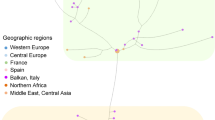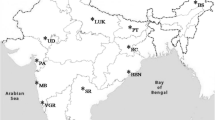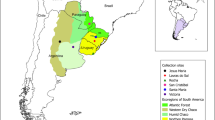Abstract
The genetic diversity amongst thirty weevils representing six Indian populations of banana pseudostem weevil i.e. Odoiporus longicollis (Oliver) was estimated by sequence analysis of the partial COI-tRNALeu-COII region. The sequences exhibited AT bias typical of insect mitochondrial DNA which was highest in the first codon position of COI and in the third codon position of COII. There was no phylogeographic distribution of the populations. The Fu and Li’s D and F tests were non-significant for this mitochondrial region. No Wolbachia infection was detected in any of the populations. The genetic differentiation amongst the populations was highly significant (p < 0.001; χ2 = 123.333; df = 75), suggesting restricted gene flow between the populations. This result did not correlate with that obtained with nuclear rDNA markers i.e. ITS1 and ITS2, suggesting a male biased gene flow between the populations.





Similar content being viewed by others
References
Ahern RG, Hawthorne DJ, Raupp MJ (2009) Phylogeography of a specialist insect, Adelges cooleyi: historical and contemporary processes shape the distribution of population genetic variation. Mol Ecol 18(2):343–356
Arthofer W, Avtzis DN, Riegler M, Stauffer C (2010) Mitochondrial phylogenies in the light of pseudogenes and Wolbachia: re-assessment of a bark beetle dataset. ZooKeys 56:269
Aylor DE, Irwin ME (1999) Aerial dispersal of pests and pathogens : implications for integrated pest management. Agric For Meteorol 97:233–234
Bandelt H-J, Forster P, Rohl A (1999) Median joining networks for inferring intra-specific phylogenies. Mol Biol Evol 16:37–48
Baskaran M (2011) Mitochondrial DNA variations and phylogenetic relationships in the Indian honeybee (Apis cerana indica F.) populations from Tamil Nadu, South India. Adv Biotechnol 11(5):12–15
Beirinckx K, Van Gossum H, Lajeunesse M, Forbes RM (2006) Sex biases in dispersal and philopatry: insights from a meta-analysis based on capture–mark–recapture studies of damselflies. Oikos 113(3):539–547
Broughton RE, Reneau PC (2006) Spatial covariation of mutation and nonsynonymous substitution rates in vertebrate mitochondrial genomes. Mol Biol Evol 23(8):1516–1524
Brown JK (1994) Current status of Bemisia tabaci as a plant pest and virus vector in agroecosystems worldwide. FAO Plant Prot Bull 42(1/2):3–32
Byrne DN (1999) Dispersal of weaker flying insects: the whitefly example. Agric For Meteorol 97:309–316
Caudill CC (2003) Measuring dispersal in a metapopulation using stable isotope enrichment: high rates of sex-biased dispersal between patches in a mayfly metapopulation. Oikos 101(3):624–630
Dellaporta SL, Wood J, Hicks JB (1983) A plant DNA minipreparation: version II. Plant Mol Biol Rep 1(4):19–21
Doums C, Cabrera H, Peeters C (2002) Population genetic structure and male-biased dispersal in the queenless ant Diacamma cyaneiventre. Mol Ecol 11(11):2251–2264
Edgar RC (2004) MUSCLE multiple sequence alignment with high accuracy and high throughput. Nucleic Acids Res 32(5):1792–1797
Frati F, Simon C, Sullivan J, Swofford DL (1997) Evolution of the mitochondrial cytochrome oxidase II gene in Collembola. J Mol Evol 44(2):145–158
Fu YX, Li WH (1993) Statistical tests of neutrality of mutations. Genetics 133:693–709
Galtier N, Enard D, Radondy Y, Bazin E, Belkhir K (2006) Mutation hot spots in mammalian mitochondrial DNA. Genome Res 16(2):215–222
Goudet J, Perrin N, Waser P (2002) Tests for sex-biased dispersal using bi-parentally inherited genetic markers. Mol Ecol 11(6):1103–1114
Gros A, Hovestadt T, Poethke HJ (2008) Evolution of sex-biased dispersal: the role of sex-specific dispersal costs, demographic stochasticity, and inbreeding. Ecol Model 219(1):226–233
Hepburn HR, Smith DR, Radloff SE, Otis GW (2001) Infraspecific categories of Apis cerana: morphometric, allozymal and mtDNA diversity. Apidologie 32(1):3–24
Horn A, Roux-Morabito G, Lieutier F, Kerdelhue C (2006) Phylogeographic structure and past history of the circum-Mediterranean species Tomicus destruens Woll. (Coleoptera: Scolytinae). Mol Ecol 15(6):1603–1615
Hufbauer RA, Bogdanowicz SM, Harrison RG (2004) The population genetics of a biological control introduction: mitochondrial DNA and microsatellie variation in native and introduced populations of Aphidus ervi, a parisitoid wasp. Mol Ecol 13(2):337–348
Kindler E, Arlettaz R, Heckel G (2012) Deep phylogeographic divergence and cytonuclear discordance in the grasshopper Oedaleus decorus. Mol Phylogenet Evol 65:695–704
Lagisz M, Wolff K, Sanderson RA, Laskowski R (2010) Genetic population structure of the ground beetle, Pterostichus oblongopunctatus, inhabiting a fragmented and polluted landscape: evidence for sex biased dispersal. J Insect Sci 10:105
Lin CP, Danforth BN (2004) How do insect nuclear and mitochondrial gene substitution patterns differ? Insights from Bayesian analyses of combined datasets. Mol Phylogenet Evol 30(3):686–702
Mantel N (1967) The detection of disease clustering and a generalized regression approach. Cancer Res 27(2):209–220
Markow TA, Castrezana S (2000) Dispersal in cactophilic Drosophila. Oikos 89(2):378–386
Memon N, Meier R, Manan A, Su KFY (2006) On the use of DNA sequences for determining the species limits of a polymorphic new species in the stink bug genus Halys (Heteroptera: Pentatomidae) from Pakistan. Syst Entomol 31(4):703–710
Nei M (1987) Molecular evolutionary genetics. Columbia University Press, New York, p 512
Orsini L, Koivulehto H, Hanski I (2007) Molecular evolution and radiation of dung beetles in Madagascar. Cladistics 23:145–168
Padmanaban B, Sathiamoorthy S (2001) The banana stem weevil Odoiporus longicollis. Musa Pest Fact Sheet No. 5
Roderick GK (1996) Geographic structure of insect populations: gene flow, phylogeography, and their uses. Annu Rev Entomol 41(1):325–352
Roe AD, Sperling FA (2007) Patterns of evolution of mitochondrial cytochrome oxidase I and II DNA and implications for DNA barcoding. Mol Phylogenet Evol 44(1):325–345
Roehrdanz RL (1993) An improved primer for PCR amplification of mitochondrial DNA in a variety of insect species. Insect Mol Biol 2:89–91
Rozas J, Sánchez-DelBarrio JC, Messeguer X, Rozas R (2003) DnaSP, DNA polymorphism analyses by the coalescent and other methods. Bioinformatics 19(18):2496–2497
Sallé A, Arthofer W, Lieutier F, Stauffer C, Kerdelhué C (2007) Phylogeography of a host-specific insect: genetic structure of Ips typographus in Europe does not reflect past fragmentation of its host. Biol J Linn Soc 90(2):239–246
Sheffield NC, Song H, Cameron SL, Whiting MF (2008) A comparative analysis of mitochondrial genomes in Coleoptera (Arthropoda: Insecta) and genome descriptions of six new beetles. Mol Biol Evol 25(11):2499–2509
Sielezniew M, Ponikwicka D, Ratkiewicz M, Rutkowski R, Dziekanska I, Kostro-Ambroziak A (2011) Diverging patterns of mitochondrial and nuclear diversity in the specialized butterfly Plebejus argus (Lepidoptera: Lycaenidae). Eur J Entomol 108:537–545
Simons C, Frati F, Beckenbach A, Crespi B, Liu H, Floors P (1994) Evolution, weighting, and phylogenetic utility of mitochondrial gene sequences and a compilation of conserved polymerase chain reaction primers. Ann Entomol Soc Am 87(6):651–701
Song H, Sheffield NC, Cameron SL, Miller KB, Whiting MF (2010) When phylogenetic assumptions are violated: base compositional heterogeneity and among-site rate variation in beetle mitochondrial phylogenomics. Syst Entomol 35(3):429–448
Sundström L, Keller L, Chapuisat M (2003) Inbreeding and sex-biased gene flow in the ant Formica exsecta. Evolution 57(7):1552–1561
Szalanski AL, Roehrdanz RL, Taylor DB (2000) Genetic relationship among Diabrotica species (Coleoptera: Chrysomelidae) based on rDNA and mtDNA sequences. Fla Entomol 83:262–267
Tamura K, Dudley J, Nei M, Kumar S (2007) MEGA4: molecular evolutionary genetics analysis (MEGA) software version 4.0. Mol Biol Evol 24(8):1596–1599
Wan Q-H, Wu H, Fujihara T, Fang S-G (2004) Which genetic marker for which conservation genetics issue? Electrophoresis 25:2165–2176
Werren JH, Windsor DM (2000) Wolbachia infection frequencies in insects : Evidence of a global equilibrium? Proc R Soc Lond B Biol 26:1277–1285
Xia X, Lemey P (2009) Assessing substitution saturation with DAMBE. In: Lemey P, Salemi M, Vandamme A-M (eds) The phylogenetic handbook: a practical approach to DNA and protein phylogeny, 2nd edn. Cambridge University Press, Cambridge, pp 615–630
Xia X, Xie Z, Li WH (2003) Effects of GC content and mutational pressure on the lengths of exons and coding sequences. J Mol Evol 56(3):362–370
Zhou WF, Rousset F, O’Neill S (1998) Phylogeny and PCR based classification of Wolbachia strains using wsp gene sequences. Proc R Soc Lond B Biol 265:509–515
Acknowledgments
The authors wish to acknowledge the Department of Biotechnology, New Delhi, India, for a research grant to carry out this work. They thank Dr. B. Padmanaban, Senior Entomologist, National Research Centre for Bananas, Tiruchirapalli, India, for his help in collection of the weevils from Trichy, Narayangaon, Assam and Wayanad. They thank Dr. Kalita, Program Coordinator, Krishi Vigyan Kendra, HRS Campus, Kahikuchi, District Kamrup, Assam and Dr. NM Patil, Entomologist, Banana Research Centre, Jalgaon, Maharashtra, for their help in collection of the weevils. PS thanks the Council of Scientific and Industrial Research (CSIR) for a fellowship.
Author information
Authors and Affiliations
Corresponding author
Electronic supplementary material
Below is the link to the electronic supplementary material.
Rights and permissions
About this article
Cite this article
Shankar, P., Kulkarni, V.M. & Kumar, L.S. Male biased gene flow in banana pseudostem weevil (Odoiporus longicollis Oliver) as revealed by analysis of the COI-tRNALeu COII region. Genetica 143, 85–92 (2015). https://doi.org/10.1007/s10709-015-9817-6
Received:
Accepted:
Published:
Issue Date:
DOI: https://doi.org/10.1007/s10709-015-9817-6




